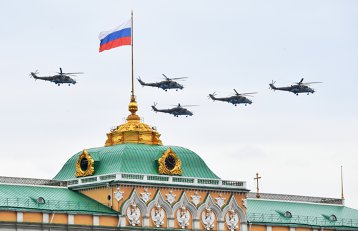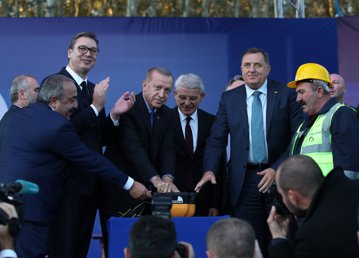
The recovery/liberation of hostages – a complementary mission of the Special Operations Forces
Although very important, the recovery/liberation of hostages is just one of the complementary missions carried out by the Romanian Army’s Special Operations Forces (ROU SOF).

But, because such kinetical actions, surprise, dynamic, violent and spectacular attacks, accompanied by muffle smoke and sounds, which demonstrate the operators’ tactical abilities (rapid rope insertion, measures to get into the objective with explosives, precision firing with their weapons and Close Quarter Battle – CQB – fighting techniques), which makes use of air support and fire support means (attack helicopters, armoured vehicles with heavy 12.7mm machine guns) and a lot of adrenaline, look nice for the spectating public and are usually the most talked about during training.
A sequence of this kind was preferred by the Defence Ministry PR during the Distinguished Visitors Day – DVDay of if what is probably the biggest national SOF drill with multinational participation in 2019, Junction Strike (JUST) 2019, which took place June this year in Romania.
Everything is good and functional when you show the public and taxpayers, in general, that the Army’s resources are efficiently used in the process of instructing and training for war. Only that the excessive mediatization of this type of actions could induce into the collective mind the erroneous idea that SOFs must be used, for the most part, in these kinds of missions.
This can have only negative consequences on the correct understanding of their place and role in the country’s security and defence architecture, but also on the level and amount of financing, the way it is organized, equipped with weapons systems. The spectrum of missions they were designed, operationalized and maintained for is much more wider, covering both the kinetic and non-kinetic components of special ops (I have listed in this article).
And, as we will see, for national territory, during peace time, the recovery/liberation of hostages is the duty of the Romanian Information Service’s (SRI) Anti-terrorist Brigade. In the interview granted during JUST19’s DVDay, the SOF commander highlighted this fact by saying that that “the mission is basically associated to the Special Interventions, Guarding and Protection Detachment of SRI, but the SOF acts in support of these elements of the national defence system”.
Legal provisions
From an international law standpoint, hostage taking during peace time is an act of international terrorism, although there are no universally-agreed definitions of these offences. During war time, this act is considered a war crime.
International law regulates hostage taking through the International Convention against the Taking of Hostages in 1979, adopted by the UN General Assembly of which Romania is a part of. According to it, taking hostages is an act of international terrorism and “whoever abducts a person (hostage) or detains and threatens to kill, injure her or that it will continue to detain her in order to constrain a third party (state, international inter-government organization, a physical or moral person or a group of person) to make whatever action or to abstain from such an action, as an explicit or implicit condition for liberating the hostage”, is committing the offence of taking hostages. At the same time, anyone who tries to commit such an act or becomes accomplice to it is committing an offence. Taking hostages is also considered a terrorist act in the content of the four Geneva Conventions and their additional I and II protocols.
For NATO, the Military concept for defence against terrorism mentions the 2012 approval of NATO’s policy guidelines on counter-terrorism and that the Alliance will continue to act in accordance with international law, the principles of the UN Chart and the Universal Declaration of Human Rights. The alliance admits that the UN Strategy to fight international terrorism, international conventions and protocols against terrorism, as well the UN’s relevant resolutions offer the framework for all the national and multinational efforts to fight terrorism.
NATO’s Allied Joint Publication mentions that the recovery/liberation of hostages is, essentially, a national responsibility and that the plans to deal with such terrorist crises are drafted and approved nationally.
There are no direct references to hostage taking in the Romanian Constitution or the Criminal Code, but instead to individual liberty and safety of the individual, and respectively illegal deprivation of liberty, which is an act of terrorism in certain circumstances.
At the same time, Romania’s Law for preventing and fighting terrorism considers illegal restraining of freedom as an act of terrorism, with the counter-terrorist operation executed by the SRI’s specialized unit (the Anti-terrorist Brigade. with the approval of the Supreme Defence Council), independently or in cooperation with other able forces, in order to annihilate the terrorists, free the hostages and re-establish legal order.
The law says that, at SRI’s request, depending on the magnitude and type of terrorist action, specific mission forces from the Interior Ministry, Foreign Affairs Ministry and the Peace and Protection Service, as well as from other security and national defence structures, can become involved. These will mostly a support role in the mission (recovery/liberating hostages) and will be led from command points with operative leadership groups, according to intervention plans.
Recovering/liberating hostages – a counterterrorist operation
In these conditions in which taking hostages is a specific model of terrorist action, recovering or liberating them is done by planning and executing a direct action within the counterterrorist intervention. The counterterrorist intervention is the totality of offensive measures aiming to capture or annihilate the terrorists, liberate the hostages and re-establish legal order following a terrorist incident.
The two co-authors of the book “The counterterrorist operation”, published in 2009 at the Military Publishing House – Eugen Badalan and Bogdan Vasile – define this direct military action, through which the forces deployed in the critical area execute the combat mission, as a counterterrorist operation.
The force structure of a counterterrorist operation contains the combat troops, strike force and the sapping squad, if necessary. The combat troops are composed of a command system, the engagement group, the reserves and the logistical system. Tactically, the engagement group represents the main component of the fighting troops and is what we actually see when we spectate demonstrative drills.
This engagement group is made out of an assault detachment (the one which executes the direct action – the counterterrorist assault), the support detachment (ensures fire support – with machine guns, assault rifles, automatic carbines etc.), the air or naval support detachment (including air or naval platforms), the negotiation for psychological influence detachment (psychologists, linguists, experts in religion etc.), the technical support detachment (communications interception, blocking communications, neutralizing detonation device through radio waves) and an isolation detachment (in order to isolate the critical area of the terrorist crisis from the nearby social or military environment).
Usually, when negotiations with the terrorists fails, a forceful intervention of the assault detachment is launched. For the intervention to be successful and all hostages to be saved unharmed, each phase of the counterterrorist operation must be planned, repeated and executed with surgical precision. The assault detachment must remain undetected to maintain the element of surprise, and once the assault begins, it must neutralize the threat and take control of the hostages immediately. If the assault mission fails, operators must be capable to execute rehearsed contingency plans.
Hostage situations are tactical actions which will continued to be used by terrorist elements trying to obtain a competitive advantage, as they are very visible and dramatic events which attract the international community’s attention.
Their neutralization requires the intervention of competent anti-terrorism capabilities able to carry out special operations with surgical precision. These capabilities are the commando-type special forces, regardless of whether they belong to the army, SRI, police, gendarmerie or other similar terrorism prevention and countering structures.
The mission’s success will ultimately depend on the command unit, the operators’ level of training and abilities, the quality and veracity of information on the ground, the execution speed and the capacity to mislead the enemy and mask your own troops.
Instead of conclusions
In demonstrative drills, everything seems well-planned, coordinated, the techniques, tactics and procedures are applied as they are, the assault is a success, the terrorists are eliminated and the hostages recovered and liberated in safety. In real life, though, when the military is faced with terrorist elements, things could not be more different.
Hostage situations are characterized by uncertainty and complex risks, and the evolution of the crisis in these types of cases remains uncertain and unpredictable, even until its final resolution. And history has shown us that managing terrorist crises had disastrous consequences in conditions of uncertainty, resulting in tens and hundreds of innocent victims.
The failures of some hostage recovery/liberation missions received intense media coverage, such as the failure of West Germany’s police to manage the hostage crisis involving 11 Israeli competitors in the Munich Olympics, in 1972, which ended in the death of all hostages.
Even the most experienced elite troops in the world, such as those of the US or the Russian Federation, have suffered resounding failures in some of their attempts to deal with terrorist crises. Two examples speak to this point.
The first is the failure of US elite Delta Force troops to end the hostage crisis at the US Embassy in Tehran, Iran (after almost five months of failed negotiations), in the spring of 1980, by performing a hostage recovery/liberation operation of 52 embassy employees who were held hostage in its headquarters by a group of Iranian Islamist militants. Although the operation was a failure, fortunately, the 52 hostages were liberated in the end.
The second total failure example is that in which Russian elite troops such as the Spetsnaz (Alpha and Vympel), FSB and OMON were unable to recover/free all of the more than 1,100 hostages (of which more than 770 were children, students and teacher) held by a Chechen terrorist commando, in a school in Beslan, Russia, in September 2004. The attack ended in the death of 334 hostages and tens of counterterrorist fighters.
Of course, there are also a lot of examples of such special operations which were successful, but reality shows that there is now guarantee that SOFs will succeed in their missions of hostage recovery/liberation, in conditions of major risk and uncertainty.
The third truth of the SOFs said that competent operators cannot be mass-produced overnight. There is a lengthy instruction and dedication process necessary to attain the professionalism level which conditions achieving success in special ops.
Translated by Ionut Preda


